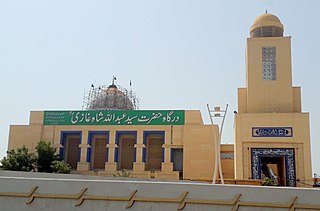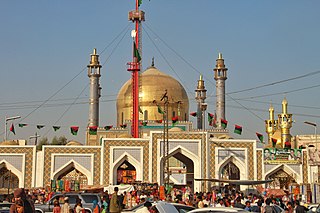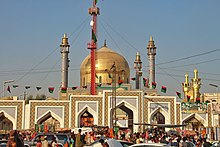
A dargah is a shrine or tomb built over the grave of a revered religious figure, often a Sufi saint or dervish. Sufis often visit the shrine for ziyarat, a term associated with religious visitation and pilgrimages. Dargahs are often associated with Sufi eating and meeting rooms and hostels, called khanqah or hospices. They usually include a mosque, meeting rooms, Islamic religious schools (madrassas), residences for a teacher or caretaker, hospitals, and other buildings for community purposes.

Sachal Sarmast or Sacho Sarmast, was an 18th and 19th century Sindhi Sufi poet, mystic and philosopher from Daraza, regarded as an important figure in the Sindhi-language literature. He is revered throughout Pakistan.

Sehwan is a historic city located in Jamshoro District of Sindh province in Pakistan situated on the west bank of the Indus River 80 miles (130 km) north-west of Hyderabad. The city is renowned for being the home of one of Pakistan's most important Sufi shrines, the Shrine of Lal Shahbaz Qalandar. The city also holds the status of taluka under the Jamshoro District. It was previously a part of the Dadu District; however, with the establishment of the Jamshoro District, Sehwan became linked with it.

Abdullah Shah Ghazi was a Muslim mystic and Sufi whose shrine is located in Clifton in Karachi, in Sindh province of Pakistan.

Baha-ud-din Zakariya, also spelled Bahauddin Zakariya, and also known as Baha-ul-Haq and Bahauddin Zakariya Multani, was a Sunni Muslim scholar saint and poet who established the Suhrawardiyya order of Baghdad in medieval South Asia, later becoming one of the most influential spiritual leaders of his era.

Haji Mohammad Alam Channa was a Pakistani farmer who was one of the tallest living people with the height of 7.8 feet (2.4 m). According to the Guinness Book of World Records, the tallest living man in the world, was Pakistan's Mohammad Alam Channa. Before his death in 1998, Channa was reported to be 7.7 feet (2.3 m) tall.
Dama Dam Mast Qalandar is a spiritual Sufi qawwali written in the honour of the most revered Sufi saint of Sindh, Lal Shahbaz Qalandar (1177–1274) of Sehwan Sharif. The origins of the poem is unknown, since no recordings or written documents exist mentioning it prior to the 1950s. However, legends around the Shrine of Lal Shahbaz Qalandar in Sehwan suggest that the original poem was initially written by the 13th-century Sufi poet Amir Khusrow, then further modified by Bulleh Shah in the 18th century. The poem includes a reference to the town of Sehwan, and the word "Lal" can refer to Lal Shahbaz Qalandar as a young man, his legendary ruby glow, or his red dress. Bulleh Shah gave an entirely different color to the qawwali, adding verses in praises of Shahbaz Qalandar and giving it a large tint of Sindhi culture. It also venerates Ali, the cousin and son-in-law of Muhammad.
Faqir Qadir Bux Bedil (1814–1873) better known by his pen name Bedil was a Sufi poet and scholar of great stature. After Shah Abdul Latif Bhittai and Sachal Sarmast, two stars that shone on the firmament of Sindhi poetry and who could measure up to them in excellence were the father and son – Bedil and Bekas. They wrote poetry in Saraiki Sindhi and Persian.

Syed Baba Fakhr al-Din al-Hasani al-Hussaini commonly known as Baba Fakhruddin was a Persian Sufi of Suhrawardiyya order from present-day Eastern Iran.
Michel Boivin is a French historian and anthropologist who specializes in South Asia. Trained in contemporary history, Islamic studies and ethnology, he is currently Emeritus Director of Research at the Centre national de la recherche scientifique and a member of the CESAH, former CEIAS at the School for Advanced Studies in the Social Sciences (EHESS). He had taught at the Université de Savoie Mont Blanc, at Sciences Po Lyon, as well as at The Catholic University of Lyon. He has co-directed three seminars at the EHESS: "History and Anthropology of the Muslim Societies of South Asia", "Authority and Politics in the Sufism of South and Central Asia", and "Material Culture and devotion among the Shia societies". In addition, he contributed to the organization of two CEIAS research groups: "Vernacular Cultures and New Muslim Elites", with Julien Levesque, and "Gujarati and Sindhi Studies: Societies, Languages and Cultures", with Pierre Lachaier.
Hakeem Fateh Mohammad Sehwani was born in 1882 at Sehwan Sharif, the then Dadu District and now in Jamshoro District, Sindh. He was a scholar, poet, literary, journalist and politician of Sindh. He died on 13 December 1942.

On 16 February 2017, a suicide bombing took place inside the Shrine of Lal Shahbaz Qalandar in Sehwan, Sindh, Pakistan, where pilgrims were performing a Sufi ritual after the evening prayers. At least 90 people were killed and over 300 injured.

The Shrine of Lal Shahbaz Qalandar is a shrine and mausoleum dedicated to the 13th century Muslim and Sufi saint, Lal Shahbaz Qalandar. The shrine is located in Sehwan Sharif, in the Pakistani province of Sindh. The shrine is one of the most important in Pakistan, and attracts up to one million visitors annually.

The Shrine of Shah Abdul Latif Bhittai is an 18th-century Sufi shrine located in the town of Bhit Shah, in the Pakistani province of Sindh. The shrine is considered to be one of the most important in Sindh, and its annual urs festival attracts up to 500,000 visitors.

Lahoot Lamakan is a sacred cave in Balochistan, Pakistan.

Syed Bilawal Shah Noorani was a Sufi saint whose shrine is located in Balochistan, a western province of Pakistan.

Bodla Bahar was a faithful partisan and devotee of Lal Shahbaz Qalandar. His mausoleum is in Sehwan Sharif, Sindh, Pakistan. His original name was Sikander. According to legends Bodla Bahar was already resident of Sehwan Sharif before coming of Qalandar Lal Shahbaz. Later, he turned to the circle of affectionate believers of the saint. He was the most reliable and trustworthy servant of Qalandar. Several myths have been related to Bodla Bahar concerning Qalandar Shahbaz. It is believed that Bodla Bahar was killed and his flesh was sold in market by butcher Annud. When Qalandar knew he called Bodla three times. After calling, the pieces of flesh of Bodla came to Qalandar and he was restored into life by Qalandar.

Syed Nadir Ali Shah, popularly known as Murshid Nadir Ali Shah, was a Sufi saint of the Qalandariyya sufi order of Islam, a Muslim preacher, ascetic, mystic, philanthropist and humanitarian. Born in Gandaf in the north-west of the Indian subcontinent, he eventually settled in Sehwan Sharif, Sindh. He was a spiritual descendant of the well-regarded Sufi saint Lal Shahbaz Qalandar and the custodian of the revered Sufi Khanqah, Kafi Sakhi Sarwar located in Sehwan Sharif. Nadir Ali Shah's legacy primarily revolves around his distinction as one of the most remarkable figures among the saints of the Qalandariyya Sufi order. He is renowned for his pursuits in Islamic preaching, mysticism, and asceticism. Beyond his spiritual contributions, he is recognized for his substantial efforts in advancing human welfare and uplifting the underprivileged, in line with the teachings of the Qalandariyya Sufi order of Islam. Notably, he also served as the custodian of the shrine of the Sufi saint Abdullah Shah Ghazi in Karachi.

Folk dances of Sindh are the traditional dances of the Sindhi people, which are indigenous to Sindh region which is now in Pakistan. These dances are performed at various events including marriages, ceremonies, special occasions, on birth of a child and for cultural purposes.


















